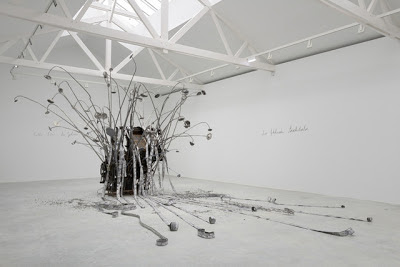 |
| Adel Abdessemed, Wall Drawing, 2006 Image courtesy Avis Culture |
This is one of two lovely exhibitions in
the Espace 315 galleries of the Pompidou Centre, spaces usually given over to newer
more experimental art. I enjoyed so much about Adel Abdessemed’s work, not least of all its ability to send a knife through the body without touching it. Perhaps
because the work was carefully cordoned off, probably because of its fragility,
looking from a distance, I felt its sharp, devastating physical impact. Looking at Wall Drawing, 2006 for example in which nine perfect circles made out of barbed wire
affixed to the wall, a chill ran across my skin. I imagined the heads caught
inside those perfect circles.
 |
| Adel Abdessemed, Hope, 2011 |
In Practice
Zero Tolerance, the two “charred cars,” that are in fact made of terra cotta, turned
over on their sides are familiar to us from Gaza, Iraq as far back as the first
war, Desert Storm, and all the other battlefields where the value of a mode of
transport is rendered the spoil of war. The charred car, usually having been
blown up by a car bomb is one of the most familiar signs of the destruction and
insanity of war. It is because these representations have a general, widespread
reference to war and violence, not just to one war in particular, that they
accrue ever more power. The notion of war is itself a problem, and there is no
point in critiquing one war in particular. It’s all the same. Hope functions in the same way. The row boat suspended by cables on its side, about to capsize, is filled with resin black garbage bags. Again, standing before it we see the waste of
destruction, the debris of an accident floating out to sea, where people have
not survived, people have not made it into the boat.
The exhibition also features a number of
videos, all of which are compelling and disturbing, all for different reasons.
In Also Sprach Allah (2008) the artist
is thrown from a blanket held at the corners and on the sides by henchmen. He
has to write “Also sprach Allah” on a prayer mat that is stretched on the
ceiling. With each throw he manages to make one mark on the carpet. The work is
apparently a reference to Goya’s El
Pelele (1792) in which a straw dummy is thrown to the sky. Without knowing
of Goya’s earlier work, the piece is easily accessible and comprehensible in
its realization of the artist as obedient, giving up individual will, whether
by force or by choice, as he takes up a role of subservience to the regime, to
God, to his role within, for Abdessemed, Islamic society. This is a world where Neitzsche (the obvious reference of the work is to Thus Spoke Zarathustra) has been replaced by Allah. Indeed, even though
there is no specific location, the videos depict a war that is everywhere and a
war that is clearly taking place in the Islamic world. A man plays a flute,
naked, the image is looped, and we are immediately reminded of the torture
rituals practiced by Americans in its recent wars. The nakedness, the effort of
playing the instrument, the repetition, it’s all a for of torture to watch as
well as to perform.
 |
| Adel Abdessemed, Also Sprach Allah 2008 |
In one of the most disturbing videos, a piglet suckles a woman’s breast in a 30sec loop. As the pig’s snout gently sucks and
massages, Lise, 2011 disturbs
because it is all at once erotic, exotic and repulsive. It is erotic for
obvious reasons, and only repulsive because of our social expectations that would
have this kind of bestiality adjudged inacceptable. But the breast is also
nurturing the pig, giving life and sustenance to the young animal. And so the
image becomes exotic and charming as the human rescues, and gives life, to the
baby animal. More than anything, it’s our responses to the image that make it
disturbing, because after all, it is just a pig suckling a woman. A no less
disturbing image is that of couples performing sex in a gallery. Here, the
audience within the film applauds, reinforcing that it is a performance for
the enjoyment of onlookers. The diegetic audience members are enthralled,
smiling, giving a response that seems superficial, inappropriate, out of kilter
with what they have just seen. The motivation for the couples’ performance is
also underlined by the fact that there is no love, the men don’t have erections,
the couples perform on cue, they make no secret of the fact that they simulate,
not have, sex. It’s these uncertainties, the ambiguities and of course the
break of certain taboos around sexuality that make this and the other videos in the
exhibition, unsettling, even confrontational.
 |
| Adel Abdessemed, Lise, 2011 |
Lastly, this is the perfect exhibition for the
industrial space of 315 sud. These spaces use the exposed air conditioning, and
the exposed infrastructural scaffolding for which Richard Rodger’s Pompidou
Centre is so famous. Abdessemed’s sculptures and video work particularly well
in here because of they complement, and effectively extend, the harshness of
the space. It is also a gallery that is both inside and outside. The floor to
ceiling windows that surround three sides of the 315 sud look out to the harsh
world of homelessness on the plaza. I visited Je suis Innocent as day turned into a cold, wet night, and the destruction
and tragedy of history echoed in the works became one with the sometimes desperate
world outsize on the plaza.






















